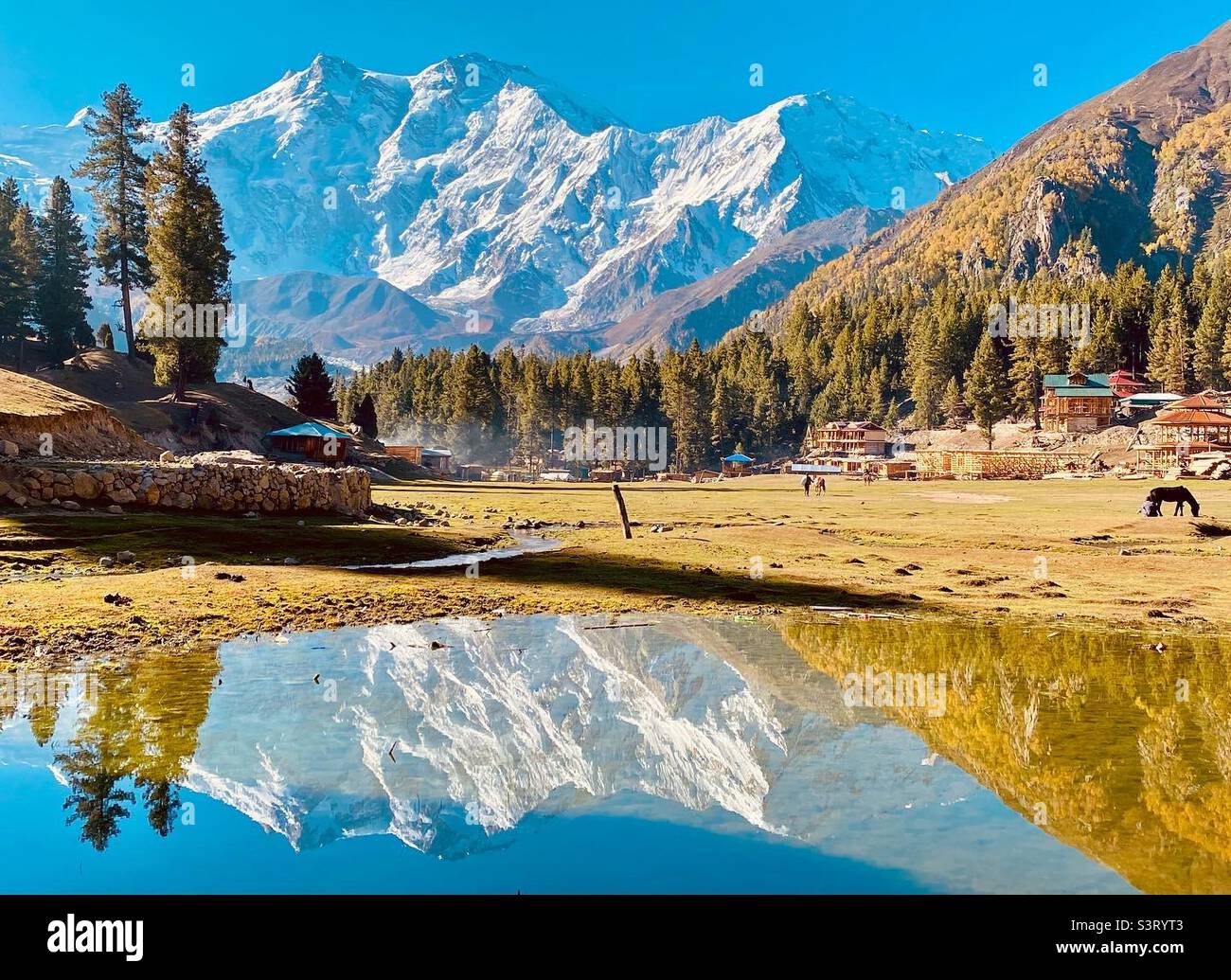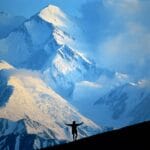Where Majesty Meets Menace
Imagine a mountain so colossal, its peak seems to pierce the heavens. This is Nanga Parbat, a behemoth nestled in the heart of Pakistan, standing tall as the ninth highest mountain in the world at a staggering 8,126 meters. Locals revere it as “Diamer,” the “King of the Mountains,” a testament to its imposing presence. But this monarch harbors a dark secret, a history etched with the harrowing tales of climbers who dared to conquer its icy heights, earning it the chilling moniker, “Killer Mountain.”
A Mountain of Many Faces
Nanga Parbat is a study in contrasts, its grandeur juxtaposed with an ever-present aura of danger. Each of its faces presents a unique challenge, a siren song to the world’s most daring climbers:
- Rupal Face: This colossal wall of rock and ice claims the title of the highest mountain face on Earth – a sheer vertical drop that steals the breath and tests the limits of human endurance.
- Diamir Face: A complex labyrinth of ridges and glaciers, the Diamir Face is a technical puzzle, demanding meticulous planning and unwavering focus from those who attempt its slopes.
- Rakhiot Face: Completing the trifecta of challenges, the Rakhiot Face offers no respite, testing climbers with its own set of treacherous conditions.
A History Forged in Triumph and Tragedy
The year 1953 marked a pivotal moment in Nanga Parbat’s history, as Austrian mountaineer, Hermann Buhl, achieved the first successful summit. But this victory was hard-won. Nanga Parbat, it seemed, was reluctant to relinquish its secrets, and many before Buhl had paid the ultimate price in their quest for the summit.
Since then, the mountain has attracted some of the most iconic names in mountaineering – Jerzy Kukuczka, Wanda Rutkiewicz, Reinhold Messner – each leaving their mark on its slopes, their stories interwoven with tales of both triumph and tragedy, forever cementing Nanga Parbat’s place in climbing lore.
More Than Just a Mountain: The Human Connection
The name “Nanga Parbat” translates to “Naked Mountain,” a fitting description for its south face, often bare of snow, exposed to the elements. Yet, for the local communities, it is “Diamer,” a symbol woven into the fabric of their lives. Their myths, their beliefs, their very existence are intertwined with the mountain’s presence. It is a reminder of the delicate balance between humanity and nature, a relationship built on both reverence and respect.
A Playground for the Adventurous, a Sanctuary to Protect
Nestled at the base of Nanga Parbat lies Fairy Meadows, a breathtaking expanse that captivates the soul. Here, the air is crisp, the views unparalleled, and the mountain looms large, a majestic backdrop to a landscape that feels both ethereal and exhilarating.
Trekkers and adventurers from around the globe are drawn to Nanga Parbat’s allure, each seeking their own unique experience in its shadow. But with such privilege comes responsibility. As stewards of this natural wonder, it is our duty to tread lightly, to embrace sustainable practices, and to ensure that future generations inherit the privilege of experiencing Nanga Parbat in all its glory.
A Future Uncertain
Even giants, it seems, are not impervious to the challenges facing our planet. Climate change casts a long shadow on Nanga Parbat, its glaciers receding at an alarming rate. This ecological shift has far-reaching consequences, impacting the delicate balance of the mountain’s ecosystem and the future of climbing on its slopes.
Preserving this natural wonder requires a collective effort, a global commitment to sustainable practices, responsible tourism, and a deep-seated respect for the delicate balance of the natural world. Only then can we ensure that Nanga Parbat continues to inspire and captivate generations to come.
Beyond the Nickname: The True Story of Nanga Parbat’s Deadly Allure
Nanga Parbat’s magnificence is undeniable, but its allure is intricately intertwined with a darker truth. This mountain, with its breathtaking vistas and challenging climbs, has also earned the ominous nickname “Killer Mountain.” But what makes Nanga Parbat so deadly, and why does it continue to beckon climbers despite the risks?
Outperforming the Competition: Why Nanga Parbat is Called Killer Mountain
Nanga Parbat holds a grim distinction in the mountaineering world. With a fatality rate estimated at 22.3%, it ranks among the most dangerous peaks on Earth. This means that for every four climbers who dare to attempt its summit, statistically, one may not return.
But what contributes to this chilling statistic? What makes Nanga Parbat such a formidable foe?
A Symphony of Challenges: Unraveling the Dangers
- Unforgiving Terrain: Nanga Parbat is not for the faint of heart. Its slopes are steep, its glaciers unforgiving, and its terrain demands technical prowess and unwavering mental fortitude.
- Erratic Weather Patterns: Located in a region known for sudden and extreme weather shifts, Nanga Parbat can transform from idyllic calm to treacherous fury in the blink of an eye. Blizzards, high winds, and avalanches are all part of the mountain’s unpredictable nature.
- The Avalanche Factor: The steep slopes and heavy snowfall create a perfect breeding ground for avalanches, adding another layer of risk to an already dangerous climb.
A History Etched in Tragedy
Nanga Parbat’s history is filled with tales of expeditions that met with tragic ends. One of the most harrowing accounts dates back to 1937 when a seven-man German expedition attempting the Rupal Face ended in disaster, all climbers losing their lives to an avalanche. Unfortunately, this was just the beginning of a long line of tragedies that would solidify the mountain’s grim reputation.
While Nanga Parbat continues to draw adventurers seeking to test their limits, it stands as a stark reminder of nature’s raw power. It is a testament to the resilience of the human spirit, but also a solemn call for respect, careful planning, and an awareness of the mountain’s unforgiving nature.
Nanga Parbat: Unveiling the Truth Behind Pakistan’s Killer Mountain
For those captivated by the allure of the Himalayas, a common question arises: where exactly does this legendary “Killer Mountain” reside?
Setting the Record Straight: Nanga Parbat’s Location
Nanga Parbat stands tall in the Gilgit-Baltistan region of Pakistan, unequivocally NOT in India. This majestic peak serves as the western anchor of the Himalayas, proudly marking the westernmost point of all the eight-thousanders – those elite mountains exceeding 8,000 meters in elevation.
A Mountain of Many Names: Decoding the Monikers
Nanga Parbat is a mountain of many names, each offering a glimpse into its character:
- “Naked Mountain”: This literal translation from the Sanskrit “nagna parvata” vividly describes its south face, often bare of snow and exposed to the elements.
- “Killer Mountain”: This chilling nickname reflects the mountain’s treacherous climbing history and the many lives it has claimed.
- “Diamer”: This local name, derived from the Shina language, translates to “King of the Mountains,” reflecting the reverence the local communities hold for this natural wonder.
Geological Significance
Nanga Parbat isn’t just a pretty face; it’s a geological marvel. This massive peak owes its existence to the ongoing collision of the Indian and Eurasian tectonic plates. This powerful clash has thrust Nanga Parbat skyward, creating its dramatic slopes and the world’s highest mountain face – the Rupal Face, a sheer vertical drop of over 4,600 meters.
Nanga Parbat vs. Mount Everest: Which Peak Reigns Supreme?
The question is a common one, sparking debate among mountaineering enthusiasts and armchair adventurers alike: Is Nanga Parbat “better” than Mount Everest?
Beyond the Numbers: A Tale of Two Giants
Let’s start with the objective data. Currently, Mount Everest claims the undisputed title of the world’s highest peak, towering over Nanga Parbat by a significant margin:
| Feature | Mount Everest | Nanga Parbat |
|---|---|---|
| Height | 8,848 meters | 8,126 meters |
| Annual Growth Rate | ~4mm | ~7mm |
| Prominence | 8,848 meters (World’s #1) | 4,608 meters (World’s #14) |
| Location | Mahalangur Himal, Nepal/Tibet | Himalayas, Gilgit-Baltistan, Pakistan |
| First Ascent | 1953 (Tenzing Norgay & Edmund Hillary) | 1953 (Hermann Buhl) |
While Everest reigns supreme in terms of sheer altitude, Nanga Parbat holds a unique distinction: it boasts a faster growth rate. While this is a geological marathon, measured over millions of years, some experts suggest that, theoretically, Nanga Parbat could one day surpass Everest in height.
Beyond Altitude: The Experience Factor
But reducing these mountains to mere numbers fails to capture their essence. The question of “better” is subjective, dependent on what one seeks from the climbing experience.
- Mount Everest: Everest is often associated with the allure of achieving the highest point on Earth. However, its popularity has led to increased commercialization, with more established routes and support systems available (for a hefty price tag, of course).
- Nanga Parbat: This “Killer Mountain” offers a rawer, less-forgiving experience. Its challenging terrain and unpredictable weather make it a formidable objective, attracting climbers seeking a more adventurous, less-crowded, and arguably, more rewarding experience.
The Verdict? It Depends on Your Perspective
Ultimately, the “better” mountain comes down to individual preference. Do you seek the glory of conquering the world’s current highest peak, or are you drawn to the untamed challenge and raw beauty of a mountain that demands respect, meticulous planning, and the willingness to embrace the unknown?
Nanga Parbat, with its deadly history, imposing presence, and potential for future greatness, stands as a powerful testament to the enduring allure of the mountains – a place where human ambition and the raw power of nature collide.
















